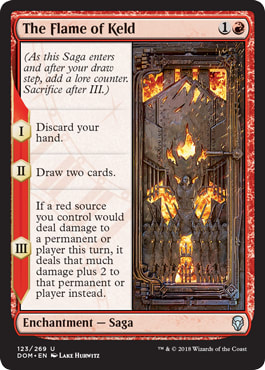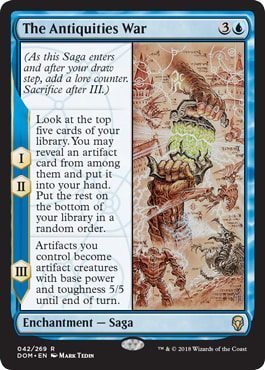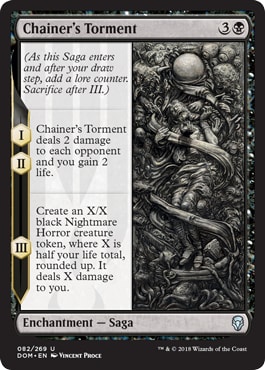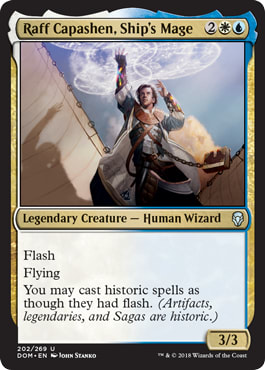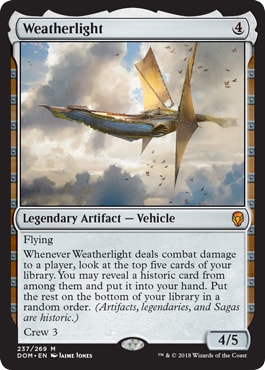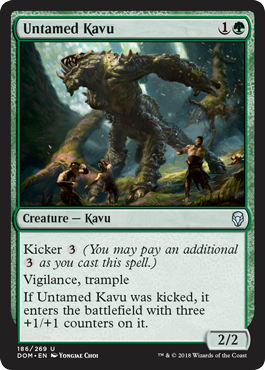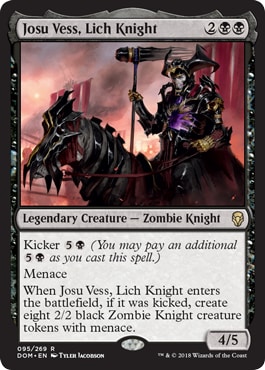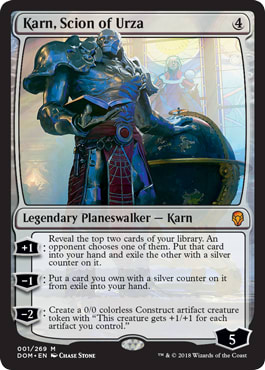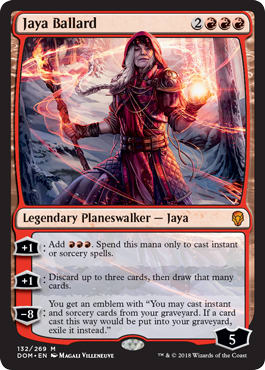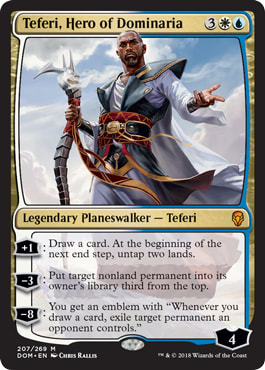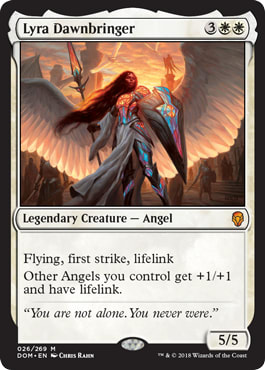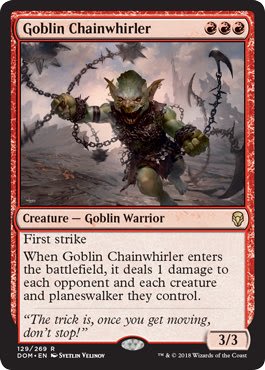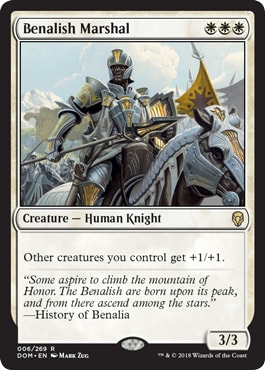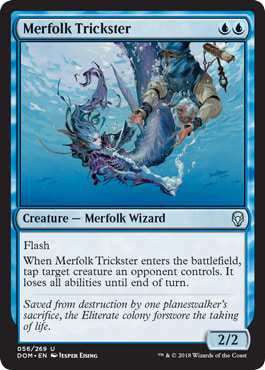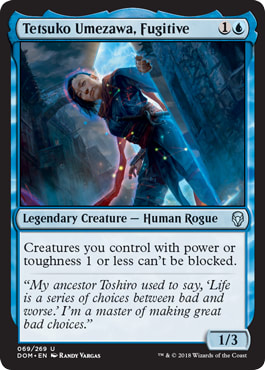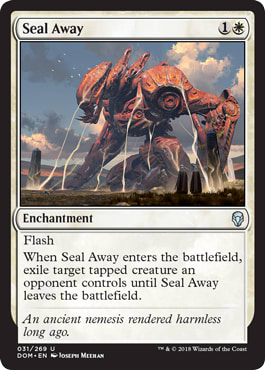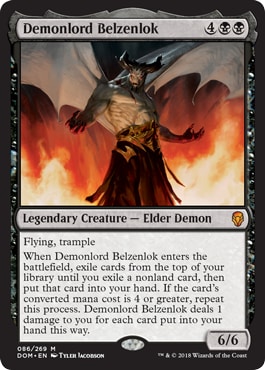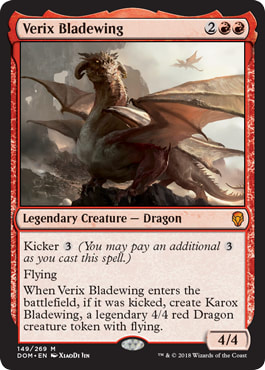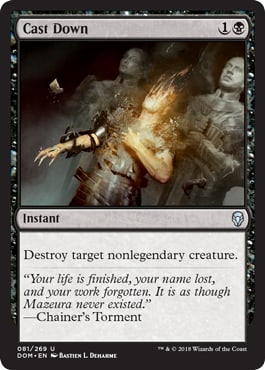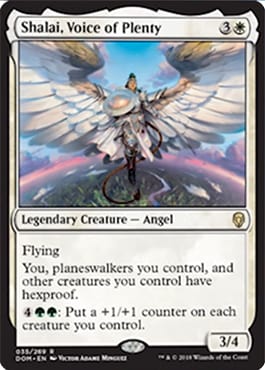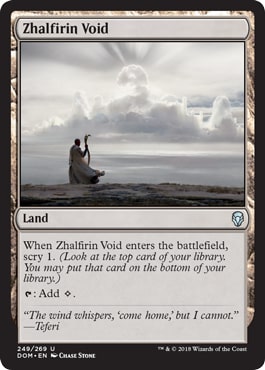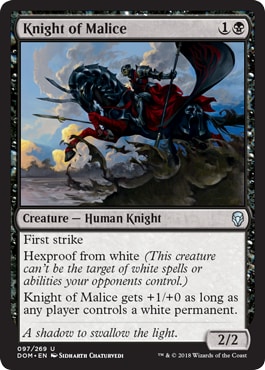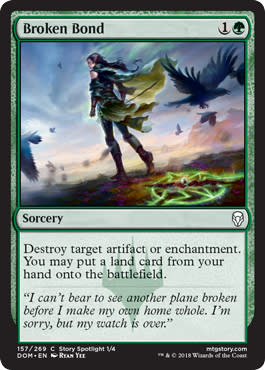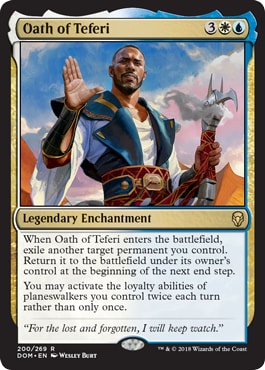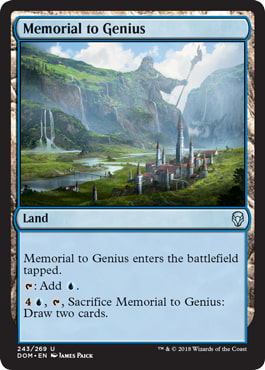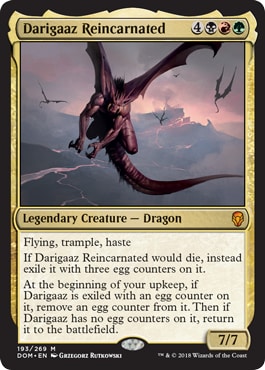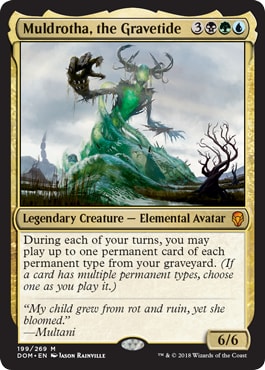Dominaria had its release notes spoiled a while ago, revealing many of the set's marquee cards. While this was unfortunate, it created an odd situation in which creators who wanted to evaluate cards were given more time to evaluate card quality. With some sets like Judgement being leaked on MTGO early, the metagame was already figured out by the time the set was officially released, while other more recent sets like New Phyrexia and Ixalan found that cards like Batterskull, Birthing Pod, Blade Splicer, Dismember, Spellskite, Hostage Taker, and Settle the Wreckage, amongst others, were given "snap-judgement" analyses after being spoiled with evaluations remaining mostly unchanged until people played the cards out and were found to be significantly better than initially thought. Elesh Norn, Grand Cenobite was previewed on the WoTC mothership, long before the Godbook leak, was relegated by many people as a bad card without having enough board impact before people played it in the pre-release and then in other formats.
I've made it a sticking point that my card evaluation is based on how cards actually play in my Cube and not outsourcing to other formats; and, despite my Cube having power, experiences tend to reflect other Cubes with rares in them. I've always worked to get a lot of reps in to get real-world information on how cards fare in Cube. With the Dominaria cards spoiled early, I was able to utilize this extra time to help refine my evaluations.
As usual, I'll break this set down by new mechanics before talking about the rest of the cards.
Firstly, Legendary Sorceries are useless in Cube, as hitting the critical mass of legendary permanents just isn't there for Cube decks. This makes them pipe dreams to achieve and not worth the payoff.
Now, on to the rest.
Sagas
Sagas are odd cards that take a few turns to fully implement, but some get around this by not requiring the use of all of the chapters.
History of Benalia is the best one as it's the most efficient by giving you 4 vigilant power before sacrificing itself. There's some additive distraction where one can think that it requires a certain number of Knights to be good in a deck, perhaps because the effect is pretty unique, but it's mainly just a bonus in case there are other Knights to boost. (Student of Warfare, Gideon, Ally of Zendikar's tokens, etc.)
The Flame of Keld is currently underrated due to it having a drawback of pitching your hand when it's cast and only boosting Red damage sources, but I've found it to be a solid card for Red aggro decks, even non-mono-Red decks as a way to fuel up after going nearly hellbent. It's better if you have several permanent-based damage sources, like planeswalkers since they're harder to interact with, but having a board of a few creatures is still nice as well. It's hardly a staple, but it's a card to keep your eye on as a way to bolster Red aggro decks.
The Antiquities War is a weird take on cards like Tezzeret, Agent of Bolas. That said, it was never really played and when I looked at the decks where it was riding the pine, I found it was a correct place for it to be. Can be slow.
Phyrexian Scriptures is not bad as "another wrath" with somewhat of a psychological factor in making it so that an opponent may not want to deploy threats after this resolves. It does allow a creature to survive, but this generally didn't seem to matter that much unless there was a creature like a Mulldrifter or a Man-o'-War hanging out. It's hardly a Damnation but like cards like Yahenni's Expertise, it's a decent tool to have to bolster non-aggro Black decks.
The First Eruption is decent for "big red" decks to get out something like a titan on turn four, but it requires the right scenario to be there and the stars to align to be worth using.
Song of Freyalise is fine to act as a suspended overrun style of card but the first two chapters are a bit low impact. Like with First Eruption, it can help to get out something larger, but it's mediocre overall.
Time of Ice is a bit too slow and low impact to compete with many Blue 4-drops, and it's a poor play on turn four when you have to tap out for it.
Rite of Belzenlok and Chainer's Torment require too much work and time for not enough payoff for the large creatures that they create due to their drawbacks.
Historic
Historic is mostly for artifacts; planeswalkers usually don't tend to contribute too much -- at least enough to swing "historic" things in a major way, but they do help to contribute hits for cards that care about historic spells.
The 2-color uncommon legends are mostly middling cards that don't do much to break through multicolored competition, but the only real exception is Raff Capashen, Ship's Mage. There's some fear of losing out from flashcasting planeswalkers, making you lose out on a turn of utilizing a planeswalker, but it makes it so that there's a tension in when to cast them and it gives you a decision to make. Many players will tend to automatically to cast everything at the last possible moment, suffering from instant-itis. It's another case where a card playing on an uncommonly seen axis very often results in people underestimating it (this will come up more in this set.) Aside from that, being able to either deploy threats or develop (via mana rocks, etc) at instant speed, without requiring the Azorius player to commit is key. Torrential Gearhulk really highlights this, at least in Standard, where having a big threat that could have been deployed at instant speed can drastically changes the texture of the game for the control player.
Fractured Identity is the premiere card like this in Azorius, but the rest is a lot like Izzet -- one top-tier card (Dack Fayden) and other good cards. This joins the ranks of other generally solid Azorius cards and inclusion in your Cube mainly depends on what you want to do with it.
The Weatherlight suffers from requiring too high a crew value to do much in Cube. Unfortunately, it's unlikely we'll see a Cubeworthy equipment or vehicle in a Standard set any time soon, and this set is no exception.
Traxos, Scourge of Kroog looks odd when viewed as a creature, but when viewed in through the lens of the Philosophy of Fire, as a source of pure damage a la Keldon Marauders, it opens another avenue of evaluation. To make Traxos work in this fashion, he needs a critical mass of historic spells to be worthwhile and, let's be honest, that will mostly be artifacts, perhaps with a planeswalker or two. You might run into the issue most artifact heavy cube decks have, like control decks, where you don't really care about Philosophy of Fire style utilization of resources; so, Traxos won't really matter for those decks. Unless Aggro decks are utilizing artifacts as a major component, Traxos doesn't really have much of a home, but it's worth a look otherwise.
Board the Weatherlight is too inconsistent for Cube. Generally, these kinds of "look at the top X cards of your library, find something" tend to fare worse in Cube because it's harder to build critical mass for the effect to be consistent enough. The average Cube deck would likely be able to use something like Lead the Stampede, and that card, rightfully, doesn't see much Cube play.
Planeswalker redirection rules change with Dominaria, but it doesn't really change the Cubeworthiness of Red burn. It's something to be aware of in game play scenarios, though. The cards that may end up losing value in Cube are some cards like Rolling Earthquake and Earthquake, while cards like Chandra, Torch of Defiance and Fiery Confluence still work well.
Kicker
I've talked about Mark Rosewater's Kavu Titan story before and, and since kicker is returning in Dominaria, it's a good time to talk about it again since it highlights an important lesson in card evaluation and gameplay.
During my last match, Randy watched. At some point late in one of the games, I played my Grizzly Bears. After the match was over, Randy informed me that the Grizzly Bears weren't actually Grizzly Bears. They were proxies for Kavu Titan. Armed with this information, the next week I went 2-2. Suffice to say that the R&D guys thought this was the funniest thing ever. The lesson I learned was the importance of using the Kavu Titans as 2/2s. When I was aggressive with Kavu Titan, my deck performed much better. When I waited to maximize the Kavu Titans as 5/5 creatures, I lost much of the aggression of my deck and thus some of its power. Week 3, I went 4-0 again."
The most obvious analog to Kavu Titan is Untamed Kavu, a strict upgrade on Kavu Titan, but better in a few ways by having vigilance and trample up-front. I slotted Untamed Kavu in for a few reps and found him to be a surprisingly good card at shoring up both the roles of an early threat/blocker or a relatively large creature.
It's odd. When I've talked about cards that occupy roles in various parts of the mana curve, I found that the best ones tend to have a good "base mode" that works well with what cube decks are trying to do; Wildest Dreams is a bit too clunky at ![]()
![]()
![]() , and its other modes for many Cube decks, but even the "base mode" of Cruel Edict on Chainer's Edict is fine, even if unspectacular. It's arguable that Untamed Kavu doesn't really have a "base mode", since ramp decks don't really care about a 2/2 and a
, and its other modes for many Cube decks, but even the "base mode" of Cruel Edict on Chainer's Edict is fine, even if unspectacular. It's arguable that Untamed Kavu doesn't really have a "base mode", since ramp decks don't really care about a 2/2 and a ![]()
![]()
![]() 5/5 trample vigilance isn't a huge payoff either. I found that, unlike a card like Burst Lightning, Untamed Kavu's base mode really depended on the matchup, which plays to how midrange decks generally play -- a 2/2 when needing to be the beatdown is a factor and a 5/5 vigilant brick otherwise. I've been pleasantly surprised with it so far and would recommend it for many lists.
5/5 trample vigilance isn't a huge payoff either. I found that, unlike a card like Burst Lightning, Untamed Kavu's base mode really depended on the matchup, which plays to how midrange decks generally play -- a 2/2 when needing to be the beatdown is a factor and a 5/5 vigilant brick otherwise. I've been pleasantly surprised with it so far and would recommend it for many lists.
Josu Vess, Lich Knight: I've talked about additive distraction in articles before and how an odd mode on a card can subconsciously change evaluation on cards, especially when it comes to a mode on a card that seems out of the ordinary.
Mark Rosewater's story about additive distraction highlights this:
To explain, imagine I made a vanilla creature (this is design so creative hasn't seen it yet):
Bear on Steroids
1G
Creature - Bear
�
If I showed that around, I'd probably get pretty good responses. We've only done one card with the same cost and stats before (Plant Elemental from Portal) and it required you to sacrifice a Forest. Now imagine I tweak the card:
Geeky Bear on Steroids
1G
Creature - Bear
If you control at least ten artifacts, CARDNAME gains trample.
�
If I show this card around, I'm going to get a lot fewer positive responses. People will focus on the condition about ten artifacts, and many will come to the conclusion that there isn't really a deck for this card.
But here's the thing: players were excited by the card without the extra line of text. Geeky Bear on Steroids is by every definition of the term "strictly better" than Bear on Steroids from a power standpoint. It has a conditional upside. It's just as good as the original and, in a very narrow case, can be even better.
My point is that how players perceive cards is very connected to how they process what's on it. Having the word "teammate" on cards was throwing people because it made them evaluate the card in terms of whether or not they might play a format where having a teammate mattered."
Because of how unique making 8 2/2s with menace is on a card, a lot of evaluation of Josu Vess made his kicker the focus and how it's not that good/too hard to achieve. Black decks don't usually hit 10 mana in cube/ramp decks will have problems hitting ![]()
![]()
![]() by Turn 10. While the first point is correct, it loses focus on how efficient Josu Vess is while unkicked as a 4/5 menace for four.
by Turn 10. While the first point is correct, it loses focus on how efficient Josu Vess is while unkicked as a 4/5 menace for four.
Check out this Mono-Black deck that won a recent draft:
Mono-Black -- Cube | Usman Jamil
- Creatures (16)
- 1 Blood Artist
- 1 Bloodsoaked Champion
- 1 Drana, Liberator of Malakir
- 1 Dread Wanderer
- 1 Etched Champion
- 1 Gifted Aetherborn
- 1 Gnarled Scarhide
- 1 Gravecrawler
- 1 Gurmag Angler
- 1 Hangman
- 1 Josu Vess, Lich Knight
- 1 Nightveil Specter
- 1 Oona's Prowler
- 1 Pack Rat
- 1 Rakdos Cackler
- 1 Scrapheap Scrounger
- Planeswalkers (1)
- 1 Karn, Scion of Urza
- Instants (3)
- 1 Cast Down
- 1 Snuff Out
- 1 Wretched Confluence
- Sorceries (2)
- 1 Divest
- 1 Inquisition of Kozilek
- Artifacts (2)
- 1 Cranial Plating
- 1 Fleetwheel Cruiser
- Lands (16)
- 14 Swamp
- 1 Ancient Den
- 1 Vault of Whispers
Hitting 10 mana in this deck is a pipe dream, but that's mostly irrelevant as it performed just fine as a giant stat monster with evasion.
Black 4-drops tend to either be creatures with strong enter-the-battlefield triggers (Ravenous Chupacabra, Skinrender), Braids, Cabal Minion, or giant stat monsters like Desecration Demon, Abyssal Persecutor, or Kalitas, Traitor of Ghet -- the last of which was underrated in evaluations because people assumed that it was bad because it didn't do anything when it entered the battlefield and his creature consumption modes were too inconsistent. Josu Vess joins the ranks of the giant stat monsters and I've found he's great in that role.
Saproling Migration is a riff on cards like Raise the Alarm, Servo Exhibition, Gather the Townsfolk, and others like Dragon Fodder/Krenko's Command. I've found that most of these tend to be just a bit too underpowered for a lot of rare-including Cubes (Raise the Alarm being the best one and one that I've liked when I've ran it in my Cube/played it in other Cubes.) Because of that, its base mode is fine and it has a built in mana sink -- an admittedly overpriced one, but kicker cards' kicker modes can be inefficient but still solid due to the flexibility that they represent.
Planeswalkers
Karn, Scion of Urza: Much like with Josu Vess, the oddness of his ability can shift evaluation negatively, and it's tempting to think that he's worse than something like Coercive Portal which guarantees a card per turn. From trying him out (as soon as he was spoiled), there's been some joking that he gets you either a good card or a land, but I've found the reality is, since you eventually get access to those cards with his -1 ability, the choice doesn't really matter unless you're digging for an out, or if the opponent just happens to be able to remove him immediately.
It's easy to also assume that this just goes in artifact decks because of his last ability, that it would suffer in Cubes without fast mana, or that it requires a heavy artifact theme to be good. This isn't really true either. In the deck above with Josu Vess, while it had some artifact cards (and likely a higher artifact density than most Cube decks), it was mainly a draw engine that could, if need be, create some Constructs to join the cause. There's some argument that Karn's only home is in artifact-heavy control decks, but I found that this wasn't the case, with these successful decks:
Mono-Green -- Cube | Usman Jamil
- Creatures (13)
- 1 Avenger of Zendikar
- 1 Courser of Kruphix
- 1 Craterhoof Behemoth
- 1 Elvish Mystic
- 1 Emrakul, the Aeons Torn
- 1 Fyndhorn Elves
- 1 Jadelight Ranger
- 1 Llanowar Elves
- 1 Oracle of Mul Daya
- 1 Primeval Titan
- 1 Tireless Tracker
- 1 Ulamog, the Ceaseless Hunger
- 1 Yavimaya Elder
- Planeswalkers (4)
- 1 Garruk Wildspeaker
- 1 Karn, Scion of Urza
- 1 Karn Liberated
- 1 Ugin, the Spirit Dragon
- Instants (2)
- 1 Beast Within
- 1 Summoner's Pact
- Sorceries (3)
- 1 Channel
- 1 Eureka
- 1 Natural Order
- Artifacts (4)
- 1 Grim Monolith
- 1 Mox Ruby
- 1 Sol Ring
- 1 Thran Dynamo
- Lands (14)
- 13 Forest
- 1 Ancient Tomb
W/R -- Cube | Usman Jamil
- Creatures (13)
- 1 Benalish Marshal
- 1 Bomat Courier
- 1 Dauntless Bodyguard
- 1 Grim Lavamancer
- 1 Hellrider
- 1 Isamaru, Hound of Konda
- 1 Leonin Relic-Warder
- 1 Mardu Woe-Reaper
- 1 Monastery Swiftspear
- 1 Skymarcher Aspirant
- 1 Stoneforge Mystic
- 1 Student of Warfare
- 1 Thalia, Guardian of Thraben
- Planeswalkers (1)
- 1 Karn, Scion of Urza
- Instants (4)
- 1 Burst Lightning
- 1 Incinerate
- 1 Lightning Strike
- 1 Unexpectedly Absent
- Sorceries (3)
- 1 Arc Trail
- 1 Chain Lightning
- 1 Firebolt
- Enchantments (2)
- 1 History of Benalia
- 1 Legion's Landing
- Artifacts (3)
- 1 Bonesplitter
- 1 Grafted Wargear
- 1 Sword of Fire and Ice
- Lands (14)
- 2 Mountain
- 7 Plains
- 1 Great Furnace
- 1 Mutavault
- 1 Sacred Foundry
- 1 Taiga
- 1 Windswept Heath
It's obvious that Karn's last ability is better with more artifacts, but it's hardly necessary to make the ability, let alone Karn, good. Even in "non-artifact decks" his ability to spam out constructs is somewhat similar to Pack Rat since it represents an exponential growth in power (although going from 1/1 to 2/2s is worse than starting at 3/3 and growing to 4/4s as those creatures tend to get out of hand very quickly). I found that this ability has been underestimated in both evaluation of the card in a vacuum and when Karn has been on the board. It's a nice way for him to not only defend himself, but to start to turn the corner and close the game out. All in all, a great card that fits into multiple archetypes and the best card in the set.
Jaya Ballard's a narrow planeswalker that only really works in a specific deck, spell-heavy Red decks. I found that even slower Red decks found her plus abilities to be clunky (especially the middle ability, which isn't even card advantage, but card parity), and aggressive decks wanted nothing to do with her. As clich� as it sounds, she has more potential to help storm decks, but overall, she fared too poorly and didn't provide enough payoff, as she couldn't protect herself. Unless she was helping to power out spells, she just didn't do enough.
Teferi, Hero of Dominaria is another five-mana planeswalker in the vein of Jace, Unraveler of Secrets and Ob Nixilis Reignited with a +1 that draws a card. His ability to untap 2 lands was useful and lines up with the cheap removal and countermagic available in Cube. Being able to tuck something into a library has proven useful in dealing with annoying permanents that could kill him. He works well in control decks and does the job better than middling things like Dovin Baan, but he's still in an odd situation where he's worse than Fractured Identity. General impressions of Teferi, Hero of Dominaria were "pretty good" and in a color combination with one standout and a lot of pretty good cards, he's another one to consider.
Miscellaneous
Dauntless Bodyguard -- it doesn't take a rocket surgeon to know that it should be played in Cubes that want to have White aggro as a healthy and viable part of a metagame and that you shouldn't cut aggressive 1-drops unless you're at the point of White aggro decks having too many and (correctly) not including them in your Cube's aggro decks.
In the Rivals of Ixalan cube review, I talked about how White 1-drops seem to be getting out of the range with mediocre upside and how the upside on Skymarcher Aspirant > things like Dragon Hunter. Dauntless Bodyguard continues this trend, and although it's not the best 1-drop to have to start your curve, shouldn't your White aggro decks have a good amount of 1-drops to start their curve? (if not, they should.)
The upside of Dauntless Bodyguard has been seen doing things like making opposing trades and spot removal awkward, and as an on-board protection from wraths -- even if it's somewhat fragile at it. Kytheon, Hero of Akros and Isamaru, Hound of Konda may comprise the god-tier of White 1-drops, but Dauntless Bodyguard is close behind and an easy include.
Lyra Dawnbringer is a riff on Baneslayer Angel, but also boosts your own angels. It's generally easier to make those angel synergies work than to bank on taking advantage of an opponent's weakness (ie. having a demon or dragon), but Lyra costing ![]()
![]()
![]() is a bit awkward since there's a glut of five-mana angels, making it hard to curve out with this. Besides, the Cubeworthy angels generally don't tend to need help in the stats department. I've found that she has some minor bonuses and drawbacks due to being legendary: you can't clone your own Lyra, it's awkward against an opposing Karakas (but great with yours) and it doesn't die to Cast Down. I also found that, generally, the angel boosting didn't matter much. Because of that, she's pretty much a Baneslayer. It's likely that your Cube can support both Lyra and Baneslayer, but include according with your Cube's needs.
is a bit awkward since there's a glut of five-mana angels, making it hard to curve out with this. Besides, the Cubeworthy angels generally don't tend to need help in the stats department. I've found that she has some minor bonuses and drawbacks due to being legendary: you can't clone your own Lyra, it's awkward against an opposing Karakas (but great with yours) and it doesn't die to Cast Down. I also found that, generally, the angel boosting didn't matter much. Because of that, she's pretty much a Baneslayer. It's likely that your Cube can support both Lyra and Baneslayer, but include according with your Cube's needs.
The XXX cycle are all mostly outclassed by their competition, because even though some may be pushed for current Standard stats, they still lag behind competition from the past years, even with three-mana creatures (generally) not being pushed as hard as one-, two-, and four-mana creatures.
Even Goblin Chainwhirler, which has an easily identifiable home in Mono-Red decks, found it wasn't enough as a mediocre creature with little board impact. Red aggro decks demand for their creatures to be incredibly efficient sources of damage and Goblin Chainwhirler couldn't represent that (and that's coming from someone who regularly preaches the gospel that Searing Blaze is a powerfully efficient card.) Goblin Chainwhirler was also nearly useless in slower variants of Red decks, and while it can sweep tokens and mana elves in Green, it just didn't do enough and was a poor performer. The other triple-mana cycle also doesn't really compare very well to existing cards -- Dread Shade looks embarrassing next to Geralf's Messenger, etc.
The only exception, surprisingly, was Benalish Marshal which has a big board impact if it resolves and can push forth a lot of damage with a team, even if cast on something like turns 5-6. It's pretty easy to underestimate how much impact it can have, even with just another creature or two to boost (and not just a nut draw curve out or with many dedicated tokens.) Look back to the deck above that had Karn, Scion of Urza and Benalish Marshal.
The deck didn't have much mana fixing but it wasn't hard to find it having an immediate and solid impact even in the later stages of the game.
Merfolk Trickster and Tetsuko Umezawa, Fugitive are decent Blue tempo creatures, which we get seemingly every set or so with cards like Warkite Marauder and Skyship Plunderer, creatures which aren't meant for the generic Blue control decks, but more so ones that take on a more proactive approach. Tetsuko Umezawa is one of the more narrow ones which is great for tempo decks to make sure that just about everything in the deck is unblockable, but really narrow aside from the Maritime Guard body (which can help stop early aggro rushes) and found it had problems that a lot of cards that were mostly there for Blue tempo decks: While great in that archetype, they were so narrow that most Blue decks didn't want it, and it wasn't really worth a slot in a Cube. Merfolk Trickster had a similar fate, although it was more universally playable. Most Blue control decks saw it as a sign of danger if they had to play this.
Seal Away is a poor card for Cube as it compares weakly to existing White removal and removal in other colors. Even mediocre-tier White removal like Temporal Isolation, Journey to Nowhere, and Declaration in Stone are arguably better than Seal Away, and those cards don't tend to see a lot of Cube play. Even compared to Condemn, this card looks abysmal, so consider this as a removal option only if other options are depleted.
Demonlord Belzenlok joins the 2nd tier of "not grave titan" for Black 6-drop finishers. His ETB trigger means that he'll at least draw one non-land card, and I found it usually doesn't get too much further than that, but it's still fine as it at least gets something useful. Having trample on a 6/6 flying body helps too. Much like cards like Massacre Wurm and Noxious Gearhulk, he's solid and is mostly interchangeable with the others, and thus, you can really choose to include/exclude as you see fit.
Torgaar, Famine Incarnate is an odd card without a real home; initial instincts may be to slot this in for token decks or as something for aggro decks, but those aren't great homes for it since it can be a nearly dead draw if there's no sacrificial fodder and aggressive decks shouldn't be playing cards with 7-8 mana CMCs. Oddly, its best home so far has been in midrange decks that utilize it as a way to go back up to 10 life and stabilize rather than dome an opponent, using things like value creatures as fodder to make it cost ![]()
![]()
![]() , which is a reasonable cost in the deck. It's not the best creature to reanimate since it doesn't protect itself very well and doming an opponent for 10 may just be like a giant Lava Axe -- useless if the opponent's life isn't pressured. But I found it was a solid midrange card, but like many things, hardly a staple.
, which is a reasonable cost in the deck. It's not the best creature to reanimate since it doesn't protect itself very well and doming an opponent for 10 may just be like a giant Lava Axe -- useless if the opponent's life isn't pressured. But I found it was a solid midrange card, but like many things, hardly a staple.
Squee, the Immortal is too low impact and slow to be able to compete with Red 3-drops in Cube. Even if Squee lives perpetually, no Red decks wanted to play him -- even slower Red decks that wanted to grind value found him too slow and weak as a (french) vanilla 2/1.
Verix Bladewing -- is currently underrated as a 4-drop that creates a sizable threat that gets absurd value if kicked and as a decent 4-drop for slower Red decks, much like Rekindling Phoenix (and similar to the phoenix, it's underrated because it doesn't fit the normal paradigm of "Red 4-drops have to have an immediate impact for aggro decks")
Territorial Allosaurus -- was a fine midrange beater as a Juzam Djinn with upside, but as creature quality has gotten better over the years, Green decks found that they didn't include it in main decks and the upside of kicking it wasn't really that great, unlike something like Verix Bladewing. Green 4-drops can use some work in Cube, but this isn't what we're looking for either. It's a bit odd that I'm saying that Territorial Allosaurus never really did much, despite it having a fine base rate, whereas Verix Bladewing has been more impressive -- it may just be because Territorial Allosaurus' kicker usually wasn't that impressive, which made his base mode his only real mode, which was generally underwhelming, rather than part of a card package.
Cast Down and Divest are unexciting, yet good, riffs on pretty base effects with a few knobs turned. By a pure numbers basis, Cast Down is better than things like Ultimate Price (and worse than Go for the Throat) and Divest is a nice card like Duress and Inquisition of Kozilek as a way to get information and usually get something valuable, as I found that Divest didn't tend to miss very often and the decks that had planeswalkers (as Divest's obvious analog is Despise) tended to have mana rocks and in most decks, the artifact count was higher than planeswalkers.
With Cast Down, it's also something to note that with brawl being introduced with Dominaria, legendary creatures being printed in Standard legal sets will be considered in that context. It's currently difficult to tell if legendary creatures will be pushed for power levels or more non-spikey legends.
In general, more creatures make it into Cubes over time because creatures keep getting better, and although good non-creature spells get printed, things like Karn, Scion of Urza and Dig through Time are more the exception than the rule. When I looked at my Cube a few years ago, I found that creatures were overwhelmingly modern faces and non creatures were vice versa, albeit not to that much of an extent, and I assume that many Cubes will have similar ratios.
It's not something you need to closely watch with every set, but the tides may turn such that there's enough legendary creatures to make Cast Downs inability to hit legendary creatures a real drawback, but we're not there yet. Both Cast Down and Divest are solid cards, hardly broken, but cards that will typically make the main deck and positively contribute to Black decks. It may be harder to include Cast Down since there are a lot of spot removal cards but much fewer pointed discard spells, but they're both overall solid Cube cards.
Shalai, Voice of Plenty -- When I introduced the concept of considering cards like Kird Ape as Gruul, people scoffed at the idea because it didn't fit the traditional methods of categorization. Eventually this became more of a mainstream point of view, but Shalai, Voice of Plenty brings up an interesting question. Obviously Shalai's Gavony Township-esque ability is a bonus if you have Green mana, but do most Cube decks want to play her for the hexproof granting? I found that generally decks without access to Green mana were able to use her, but preferred other 4-mana things in White, since they're just so powerful, making her a Selesnya card. Because of this, as clich� as it is to say, she had a hard time making it in. She does die to removal as well, but at least usually required respecting and doing something about her. She may have a hard time making into Cubes due to how good Selenya cards are, though.
Zhalfirin Void is a subtly powerful and useful effect, since it's a scry stapled onto an untapped land, making it much better than trash like New Benalia (somewhat analogous to the Temples?). It makes curving out easier, so it was pretty useful in not just midrange and control decks, but even aggressive decks. It feels like Zhalfirin Void has been underrated overall. Don't sleep on this.
Zahid, Djinn of the Lamp -- played better than initially thought, and it seems he's going under the radar for many. He something that pairs well with equipment and even mana rocks as a five-mana thing. I found it's not bad as a "big dumb idiot" that can be cheaper but fine if cast at retail. But Blue has a lot of "big dumb idiots" a la Frost Titan, Torrential Gearhulk, etc. I've found it's not too hard for it to be a 5-drop (admittedly, I run more artifacts than most Cubes, FWIW. Comparison to the delve monsters is somewhat true, where it's not the most embarrassing thing when cast for retail, since the skies generally don't have things that can fight with this and live.)
Multani, Yavimaya's Avatar is similar to Belzenlok as a creature that's clearly behind the colors respective titan, and its 2nd tier of 6-drops being serviceable, but replaceable. Growing based on lands makes him a poor creature to reanimate or ramp out with elves/mana rocks, and his Regrowth ability doesn't help either. He's great with Armageddons and, depending on timing, Wildfire/Burning of Xinye and works synergistically in the same decks that play Titania, but getting Multani to be large enough to be a threat based on lands in the graveyard (even with fetchlands) is too much effort for Green cube decks.
Knight of Malice and Knight of Grace -- Black and White aggro creatures have gone a long way in the past few years; cards like the original Black Knight and White Knight were used to make sure that aggressive decks had a critical mass of decent creatures to fill out the early parts of the mana curve. Since then, aggro creatures have gotten much better with cards like Adanto Vanguard, Kitesail Freebooter, Pack Rat and Glory-Bound Initiate making it so that the tough-to-cast Knights made their way out of many Cubes. The new riffs are easier to cast, but they still don't provide enough raw power in matches where their protection doesn't matter, so including these in a Cube is highly unlikely.
Broken Bond is fine if there are a lot of artifacts, but looks better than it is from nut draw scenarios (killing a mana rock on Turn 2, getting a land out.) Mediocre otherwise. Alex Ullman pointed out that it's an Explore, but instead of drawing a card, it Naturalizes. However, unlike Explore, it requires a target to use, and thus there are scenarios where there's just nothing to cast and its Explore ability is useless. This makes it so that it's better in Cubes that have access to fast mana via artifact sources, but relatively poor outside of scenarios when the opponent just happened to have something out early. As good as this looked, I found Broken Bond unsatisfying for Cube.
Since Unwind is a reactive card (with restrictions, no less) even being a free card is harder to utilize than one would think and getting value out of the untapped lands requires having another spell or ability that can utilize the mana. Although this is how Blue decks generally want to operate, this doesn't always happen. Because of this, Unwind is fine, but likely not going to make waves or even make it into many Cubes.
Fungal Infection was a surprising card to find as a decent 1-mana removal spell with the potential for great value, more so against aggro decks where it acts as a 2-for-1. One-mana removal in Black doesn't tend to get represented a lot in Cube, with Fatal Push doing the best while cards like Tragic Slip, Disfigure, and others fall by the wayside. I saw some blowout scenarios where it was a 2-for-1, and it's almost assuredly going to make it into my Pauper Cube, but its suite of creatures that it can effectively kill are low enough to have this on the outside looking in for many Cubes.
Oath of Teferi is a bit too clunky for Cubes, although it has an absurdly high ceiling for ramping out ultimates and grinding out value with Planeswalkers. It's a bit too pricey without having a planeswalker out, but it's still fine as a medium-power Azorius card as a potential build around, or at least, payoff card for making a Super Friends style of deck.
The Memorial land cycle are too low impact and slow, since they come into play tapped. The best hope is Memorial to Genius, but is it even better than Blighted Cataract? Memorial to Glory is also something that may be worth considering as a way to create creatures out of a land source, but it's still just too slow.
Darigaaz Reincarnated -- although it has the ability to recur, it's glacially slow to do so. Jund doesn't have a standout card for its tri-color shard -- cards like Sprouting Thrinax aren't able to be utilized as well as it was while in Standard and cards like Hellkite Overlord/Broodmate Dragon are decent ramp/Natural Order/reanimation targets. Darigaaz Reincarnated join the ranks of the big dragons, but its recursion ability is incredibly slow, requiring three turns to go off. It's at least free to bring back, but it's still just too slow.
Muldrotha, the Gravetide suffers similarly as a big value thing. It has the potential of a card like Ramunap Excavator to recur lands, albeit on a bigger scale, but it suffers similarly (and can't hold a candle to something like Leovold, Emissary of Trest.)
Jodah, Archmage Eternal is similarly too low impact. It's fine as a way to push high-cost things like Eldrazi to be cast for ![]()
![]()
![]()
![]()
![]() , but it's still just too narrow, since, although he costs Jeskai mana, he's a rainbow card, making it so that only 5-color decks want this.
, but it's still just too narrow, since, although he costs Jeskai mana, he's a rainbow card, making it so that only 5-color decks want this.
Thanks for reading!
My blog, featuring my Pauper, Peasant and powered Cube lists (I frequently update my powered cube list, but it hasn't been updated on CubeTutor. Expect an update shortly after Dominaria is live on CubeTutor)
Cube podcast, The Third Power, that Anthony Avitollo and I host.
Find me on Twitter @UsmanTheRad
*When referring to "people," I'm not referring to Cube content creators, but the general M:TG community at large.















